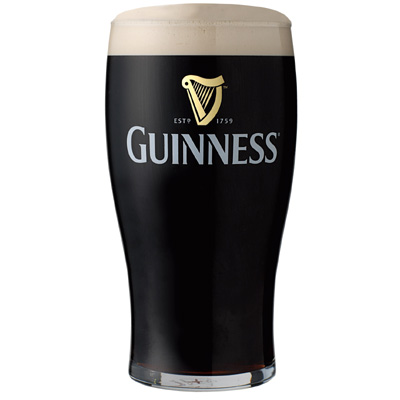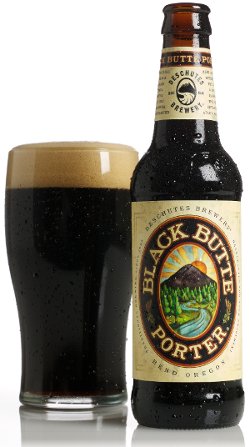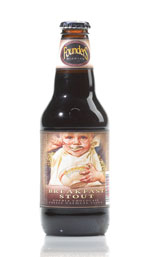Within the green bluffs of Ireland, just south of the River Liffey, the cradle of Guinness endures at St. James’s Gate in Dublin. It is at this brewery, going back to 1759, where one life was born, another life fortified.

So often does one life impinge the other that some Irish translate them through song and dance. Or, in the case of “The Workmans Friend” by Flann O’Brien, through rhyme.
When things go wrong and will not come right,
Though you do the best you can,
When life looks black as the hour of night —
A pint of plain is your only man.
Americans don’t do this. Well, most Americans, at least. They don’t sing or dance or write poetry about porter or stout, and the vast majority of Americans don’t drink the stuff either. If you drink domestic, it’s lagers and light lagers or you may go back to where you came from, thank you very much. If you drink craft, as our readers know well, it’s mostly IPAs and pale ales. IRI, a Chicago-based market research firm, found that as of December 1, year-over-year, sales of IPAs led all beer styles in market share at 18.5 percent. Aside from seasonals, pale ales followed at 11.6 percent. Porters and stouts combine to form just more than 2 percent. That’s closer to M├ñrzen than monopoly.
Despite these trends, the healthy condition of the craft beer industry enables most brewers to cover the top two styles and to examine what lies beyond. For the brewer and the drinker, the act of delving beyond the familiar creates one of the most alluring dimensions of the movement. Brewers aiming to reach this point — to define a brewery by its fabric and its fibers, rather than outside fashion — continue to make porters and stouts. And as drinkers gradually dismiss the psychological hindrances of darker beer, the creations register.
“The love affair with hops continues,” said Jason Randles, marketing manager for Deschutes Brewery in Bend, Ore., “but there’s a place for porters and stouts.”
Fear of the Dark
Knowing the tradition and technique that goes into stout manufacture, shouldn’t darker beers have caught on among the new crop of beer connoisseurs?
“There’s still a fairly common perception among a lot of beer consumers that darker beers are inherently heavier beers,” said Bob Kaiser, senior sales analyst at Founders Brewing Company. “That creates a certain barrier to entry for some consumers to something like a porter or a stout. That assumption that ‘look how dark it is, I bet that thing drinks like motor oil.’”
However, despite the perception, well-made porters often possess a lighter body than IPAs, Kaiser said. Porters and stouts have the ability to encompass a wide range of characteristics, including flavor, mouth feel and viscosity, alcohol content, smell and appearance. The flexibility explains their compatibility with barrel-aged beers, another trending technique.

Tyson Starling, operations manager, said that he can understand the initial fears of beer drinkers, especially considering the nation’s long-lasting bond with light lagers. Cadillac Mountain Stout represents a deep departure from what’s comfortable.
“When it was poured into a pint glass and it was dark and you couldn’t see light through it,” Starling said, “it was just intimidating.”
When Starling worked as a sales representative for the brewery, he often heard that consumers don’t like dark beer. The color immediately triggers conjectures of strength and a high alcohol content. This, he said, has repressed porters and stouts.
Randles said that he often encounters this psychological hindrance. He recently spent some time in Philadelphia conducting tastings, where people said that they don’t like dark beers.
“They think dark is a flavor,” Randles said.
He then asked these same people if they like chocolate or coffee. The responses, as one might imagine, were much more favorable. After persuading them to try the beer, many were surprised by its smoothness. Most enjoyed the beer. The education had begun.
The psychological hindrance, typically between the look or taste of porters and stouts, depends on the person, Randles said. However, the representatives of Deschutes and many other breweries will do their best to disprove the conjectures.
“That’s the challenge we have,” Randles said, “is that education and getting people to sample it.”
The Welcoming Atmosphere
As the spreadsheets suggest, this isn’t the heyday of porters and stouts. Starling said that occurred probably about 10 to 15 years ago, when brewers weren’t as accustomed to hoppy beers and instead followed their red and brown ales with a porter or stout. When Ken Grossman was fiddling with the recipe of Sierra Nevada Pale Ale in the fall and winter of 1980, he wasn’t exactly tailing the trends.
“I think that they were an anomaly in the onset,” Starling said.
However, whether or not it’s the heyday, the current state of the craft beer industry hasn’t hampered the styles. Rather, it’s buttressed them. As the industry continues to gain momentum and seize market share from domestic beers, craft brewers are attaining more and more tap handles in bars, the hubs of examination.
“It’s easier,” Starling said. “The price point and the commitment is much less when you go to a bar and buy a pint.”
When you go to a bar and dislike a beer you ordered while squinting at the inevitable chalkboard menu, it doesn’t burn the same way as when you swing and miss on a 6-pack. When you dislike a pint, at least you’ve got the ambiance (or opposite) and social climate of a bar. But after heading to a liquor store, browsing the well-lit aisles, making the purchase and going home, one disappointment could dampen the interest of an entire beer style. At a bar, a bad pint discourages only until the next pint.
As craft beer continues to expand its presence, barkeeps can add and diversify their taps. This helps to prevent rows of IPAs, pale ales, lagers and nothing else. Yet, these bars haven’t been the only places that encourage experimentation among beer drinkers.
In January, market research firm Mintel projected that craft beer sales, which more than doubled from $5.7 billion in 2007 to $12 billion in 2012, will reach about $18 billion in 2017. Growing with the industry are off-premise retail accounts, such as Walmart and BP, and beer-focused events, such as The Great American Beer Festival. There are so many beer festivals of all sizes that you could trade your church membership for a sturdy tent and spend the same amount of time away from home. This blend of exposure has opened the minds of formerly rigid drinkers.
“People are getting less timid to try different beers,” Starling said.
Padding the Foundation
The longstanding place of Guinness as a snob-worthy brew and the growth of a handful of other porters and stouts, such as Left Hand Brewing Company’s Milk Stout, shows that dark beer styles can serve as the lynchpin for a successful brand. While these styles haven’t woven into the cloth of American tippling history, they’ve established themselves as left field cornerstones in an industry that bears a similar outsider’s identity.

Deschutes proudly dubs the beer the top-selling craft porter in the country. According to IRI, as of Nov. 3, year-over-year, Black Butte and its limited-release variations hold 45 percent of dollar sales market share within the U.S. craft porter category.
“Black Butte Porter is our signature beer,” Randles said. “It’s what put us on the map, so we can’t walk away from that.”
However, even with Black Butte’s success and critical adulation, it still isn’t the top-selling beer for Deschutes. That title goes to Mirror Pond Pale Ale.
Another anchor from the dark-beer department: Founders Breakfast Stout. Adored for its chocolate and coffee notes, cinnamon-hued head and amusing label, which features a baby spoon-feeding from a bowl that dons the brewery name, the beer continues to perform in the market when it’s on sale. This year, that’s from October through December.

And as they so often do, other breweries have felt the nudge. Kaiser said that as a result of both the interest in the styles and the welcoming industry, new takes on porters and stouts continue to surface.
Among several other examples, the following news was announced in December alone…
- Dec. 2: Stone Brewing Company announces the imminent debuts of Stone Smoked Porter with Vanilla Bean, Stone Smoked Porter with Chipotle Peppers and Stone Smoked Porter — Harvest Addition Edition.
- Dec. 3: Allagash Brewing Company announces that Red Howes Stout, a cranberry imperial stout, will be aged in bourbon barrels for “a little while.”
- Dec. 9: Jeremy Danner, brewer at Boulevard Brewing Co., announces the return of Imperial Stout to the Smokestack Series, a collection of more esoteric beers.
- Dec. 12: Upslope Brewing Company announces the re-release of Foreign Style Stout, which was originally brewed as a first-anniversary ale.
- Dec. 16: Narragansett Brewing Company releases Autocrat Coffee Milk Stout, a blend of the brewery’s milk stout with dark coffee from Autocrat, also based in Rhode Island.
The beers are on their way, but it will take time for this country’s beer drinkers to shift their perceptions, diverge from what’s most familiar and embrace these offerings. For now, the craft beer industry will continue to work with the minority.
Take Deschutes. Randles said that the brewery’s most fanatical fans drink Black Butte.
“That’s the beer that people name their dogs and their kids after,” he said.
That’s no poem, but it ain’t bad either.
